How far should you stand? Where should you bend from? Tips for a professional golf stance.
How far from the ball should you stand? How far should your hands be from your body? Should you bend from the waist or the hips? Where should you ‘feel’ your body weight ? What should the role of your right elbow be?
These questions puzzled me as a beginner – and I asked it of every coach I worked with. After half a dozen coaches or so – I finally learnt some of the answers. In the process, I learnt what differentiates the PROFESSIONAL stance from an amateur stance. This post describes some of the lessons learnt.
How far should you stand? How far should your hands be – from your body?
Essentially, the lie of the club will provide you with this answer. You see, the club was designed to be GROUNDED in a particular way (squarely). Once you GROUND the club correctly (Squarely), the shaft will rest at a particular angle. Now, just place your hands on the grip – and you are at the correct distance from the ball!
In other words, if the clubface is NOT correctly grounded, the shaft will pull you closer or further from the ball – because it will be ANGLED incorrectly. With correct grounding, the shaft creates the correct separation between your body and the ball.
Most amateurs pay little attention to the grounding of the club. The clubface is rarely SQUARE. SQUARE means pointing down the target line – and the center of the clubface directed at the ball (see image below).
Once your club is correctly grounded at address (see image below), your hands will be a certain distance from your body. This distance of the hands from the thighs – is fixed regardless of the club you use. The exact same hand position works for the driver as it does for the pitching wedge (full swing). Don’t believe me? Take Tiger’s instructional tips then (in his classic ‘How I play golf’) , Tiger addresses this very question.
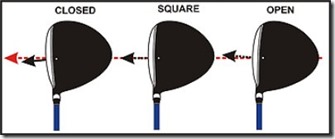
Square versus ‘Not Square’ Clubface |
Arms Hanging – but how?
All golf instructors will talk about ‘letting your arms hang’ while taking your stance. If you observe any pro, you will notice that – inevitably, their arms hang at address – and seem completely relaxed.
Personally, in spite of half-a-dozen coaches asking me to ‘hang my arms’, I had a lot of difficulty with this seemingly simple task. My arms would be tense or my shoulders would be tense (causing my arms to be tense).
It wasn’t till a few coaches later (I got myself a ‘playing’ coach – someone who walked the course with me while I played – and observed my flaws..) – that I learnt exactly how pros accomplish this ‘arms hanging’ business.
Simply stated, your WEIGHT needs to REST on your knees. When you adopt your stance, it is possible to support your body weight in a variety of ways. It is essential that you ‘feel’ your upper body weight on your knees. If you are having trouble getting to this point, ensure that you are bending from your HIPS and not your waist (and especially not your shoulders or chest).
This simple exercise of RESTING your upper body weight on your knees will automatically cause your arms to hang.
Arms hanging loosely (above)
Butt Pushed Out (Protruding butt – acts as a counterbalance)
Once your weight is resting on your knees, your arms are hanging correctly. This is desirable – but comes with an associated problem. Your full body weight on your knees might make your knees a little ’wobbly’. Chances are your knees will not be able to HOLD their position while the body executes its turn away from the ball.
This is where your butt comes in. Your butt can act as an ANCHOR for your wobbly knees. Just push your butt out a little (as if you are about to sit on a bar stool) – and you will have the counter weight needed. Once in this position, you should feel STABLE – i.e. – you should feel like nothing will ROCK you (or sway you) during your upper body turn (backswing).
If you have observed pro golfers taking their stance, you will have noticed the prominent ‘protruding’ butt (observe Michelle Wie and Rory MclRoy’s stance below).
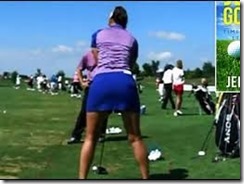
|
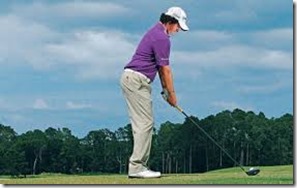 |
Width of Stance ? Role of right knee ?
How wide should your stance be? Shoulder width (for a full swing) is the most commonly accepted answer. But how does one arrive at this width? The easiest way is to visualize your HEELS – falling directly beneath your shoulders (tips of the shoulders). This provides an easy visual – and gets your width to be the correct separation. Narrower than this and you could easily get off balance (Read more great tips from Adam Scott in this post).
While pushing your butt out may help you attain the stability you need, sometimes pros need additional stability for those huge windups that they need to take. This is best attained by a flexed right knee that is turned INWARDS. This inward pointing of the right knee makes it rock solid and resistant to any sway. This is a tip that Ben Hogan talks about in his classic ’Five Lessons’. Several golfers I play with use this to get additional driving distance off the tee.
Knee Flex ? How much and to what end?
Most amateurs do not have sufficient knee flex. Just like the arms hanging loose concept, this knee flex concept was also difficult for me to achieve in practice. Until I learnt from a coach the real purpose of the knee flex. I know it sounds obvious, but the real purpose is ‘stability’. As the knees flex, the feet dig deeper into the ground (not really – but you get the feeling that they are). All that talk about ‘athletic position’, ‘you should feel like you are about to jump straight up’ etc. confused me – since the purpose of ‘jumping straight up’ was very different from the objective of GROUNDING one’s feet.
In fact, you should flex your knees at the very end of taking your stance. This will ensure that your ‘stance – as is’ – digs deeper into the ground for additional stability. Once you get this ‘grounded’ feeling, your swing becomes a little simpler – all you need to do is maintain this flex on your way back (and way down). There are many different ways of realizing this swing thought. Stay Level throughout the swing, Keep your eye on the ball – are all variations of ‘maintain your knee flex’ throughout the swing.
A simple drill for maintaining knee-flex is to place a soccer ball (or basketball) between your knees as you practice your backswing. Ensure that the ball doesn’t drop – and you have successfully maintained your knee flex.
Right Shoulder Lower, Right ELBOW Relaxed
Having dealt with the lower body (knees , butt, hips…), it is time to take a look at the upper body. Most importantly, the right side of the upper body (which is chiefly responsible for incorrect golf setups). The right shoulder and the right elbow are the most oft misplaced body parts. The right shoulder should necessarily (and naturally) rest LOWER than the left, due to the right hand resting lower on the grip. The right ELBOW needs to be relaxed and bent – so that it doesn’t resist the turn (around the spine).
Unless your arms hang correctly (as described above), the right elbow will not be relaxed. For arms that are even slightly tense, it is difficult , if not impossible to relax the right elbow (hence the golf maxim that ‘tension is the biggest killer of the golf swing’).
The right elbow needs to be relaxed and bent – it’s job is to simply go along for the ride as the backswing is initiated.
Observe the correct ANGLES formed by the right angle at SETUP, BACKSWING and DOWNSWING – in the image below. These angles are not just academic – it is the RELEASE of this ELBOW ANGLE that provides power in the impact zone (hip height to the ground). Johnny Miller’s classic ‘Pure Golf’ describes this release of the angles beautifully.
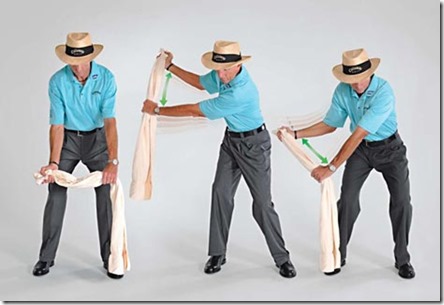 |
Summary
It is important to stay balanced, to bend from the waist, to let your arms hang – and to relax your right elbow – while taking your golf stance. While that may sound like a lot of things to remember, they are all connected – and sequential. Without a bend from the hips, you cannot get your weight on the knees. Without your weight on your knees, your arms will not hang in a relaxed manner. Without your arms hanging, your elbow cannot be loose and relaxed.
Without a relaxed elbow, your backswing will most likely be off-plane (since the right elbow may not FOLD in correctly).
If you can mimic the professional stance as described in this post, you will notice an effortlessness creeping into your golf swing. Nicklaus once stated that golf is ‘90 % setup and 10 % swing’. If you can relate to this aphorism, you will realize that most of your SWING faults are a result of a faulty setup. A better stance greatly improves your chances of making ‘center of the clubface’ contact. As an added benefit, you may even look like a pro when you address the ball !
Questions? Comments ?
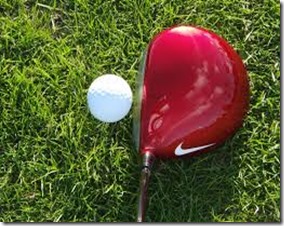
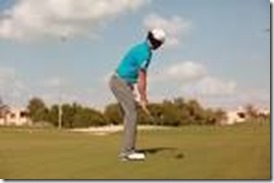
Leave a Reply